This offseason will be a summer of change for the Toronto Maple Leafs.
After the team’s third consecutive first-round exit, both the organization and fans alike expect better. And it looks like the first wave of change will come in the form of a revamped coaching staff.
On May 12, Elliotte Friedman reported that both of Mike Babcock’s assistants, DJ Smith and Jim Hiller, would likely be moving on. This past week, those speculations have become reality. On the morning of May 23, the Ottawa Senators announced the hiring of Smith as their new head coach. Hours later, the Maple Leafs filled that vacancy by hiring former Florida Panthers assistant coach Paul McFarland.
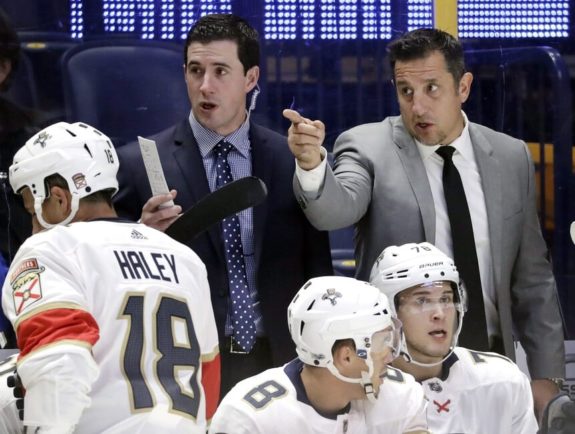
It’s expected that McFarland, who ran the Panthers’ second-ranked power play this season, will assume the same role for the Maple Leafs. Fans are already brimming with excitement and expectation about what the Richmond Hill-native will bring to his new club. But setting that excitement to the side, what kinds of changes can we expect to see from the Maple Leafs’ power play next season? And will McFarland be able to improve on what was already one of the most dangerous power plays in the league?
Evaluating the Maple Leafs’ Power Play
The story of the Maple Leafs power play in 2018-19 was a puzzling one. They stormed out of the gates in October with a 32.3 percent conversion rate – good for second in the league. They understandably cooled off in November, but still posted a terrific rate of 24.3 percent. December marked the beginning of the drought where their power play dipped to 16 percent, and things worsened in January as they scored on just 11.8 percent of their man-advantage opportunities. The Maple Leafs rebounded in February to the tune of 23.9 percent, and then ended the season on a decline 18.6 percent through March and April.
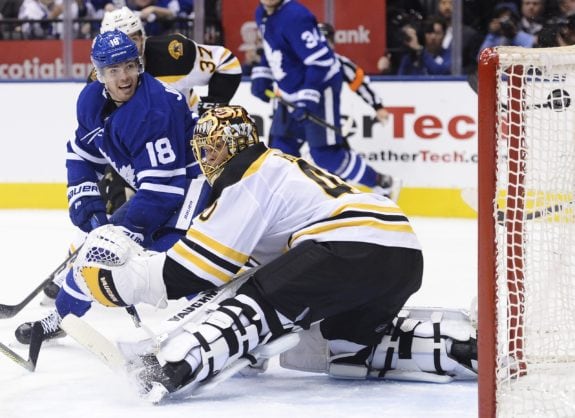
They finished the season with 46 goals on 211 opportunities (the fewest in the league), good for 21.8 percent and eighth overall.
Some might argue that the power play faltered down the stretch due to an overreliance on set plays, which opposing teams were able to read and defend. The underlying numbers, however, tell a different story.
The Leafs Should Have Scored More
If we look at their 5-on-4 expected goals over the course of the season, we see a similar pattern: the Maple Leafs’ power play peaked early on in October and November, had a gradual decline before bottoming out hard in January and early February, then recovered a bit to end the season.
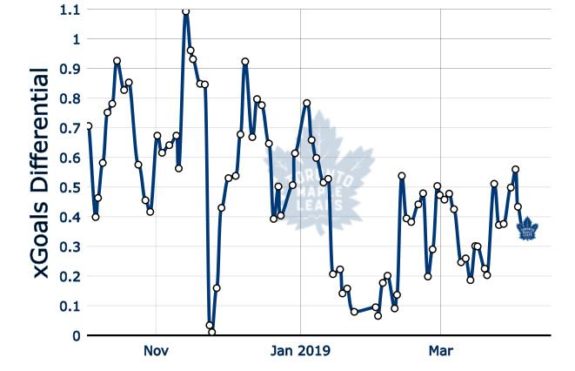
But despite all of the ups and downs, and the looming sense of disappointment, the Maple Leafs’ power play was actually one of the best in the league in terms of generating shots and scoring chances. According to Meghan Hall, who collated data from Evolving Hockey, Corsica, and Money Puck, Toronto had the second best power play in the league based on expected goals at 8.5-per-hour (the Pittsburgh Penguins were first at 8.7). They also ranked first in terms of shots-per-minute.
Looking at the shot map, it’s clear just how dangerous their power play was this season. The Maple Leafs were able to generate a ton of shots from the slot, which is exactly where you want to be. Given the quality of their shots and the shooting talent on the team (with players like Matthews, Tavares, Andreas Johnsson, and so on), it’s hard to believe that they didn’t score at a higher click on the man-advantage.
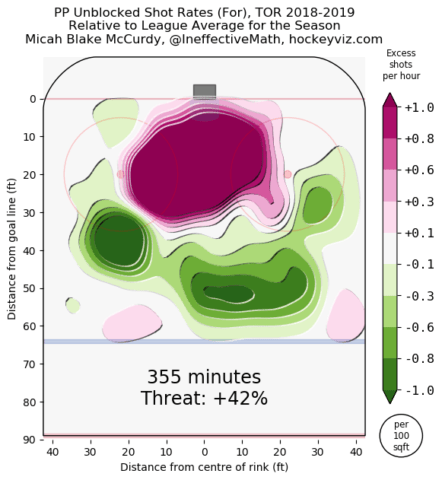
The Maple Leafs somehow managed to shoot just 12 percent on the power play – 20th in the league. Some of that is being stoned by opposing netminders, and some (or a lot) of that is plain bad luck. Matthews was actually the only forward on the team who outperformed his individual expected goals (ixG), while several others vastly underperformed. No matter how you look at it, the Maple Leafs certainly deserved more than the 46 goals they scored on the power play.
| Player | Powerplay Goals | Expected Goals (ixG) |
| Auston Matthews | 12 | 7.60 |
| John Tavares | 10 | 14.09 |
| Nazem Kadri | 4 | 9.29 |
| Patrick Marleau | 4 | 4.94 |
| Mitch Marner | 3 | 3.89 |
Looking back at their power play in 2017-18 also confirms the notion that they were unlucky this season. While running a very similar set-up, they scored 25 percent of their opportunities – second in the league. The only real difference was that they had better shooting luck (James van Riemsdyk’s scoring touch in front of the net didn’t hurt either).
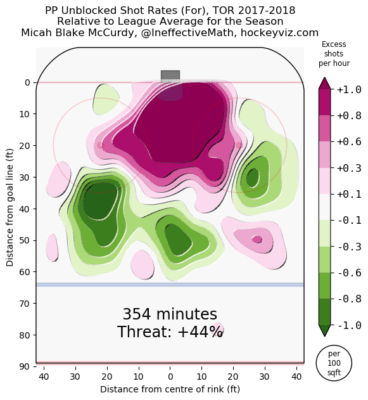
Ice Time Issues
Perhaps one of the biggest complaints of the Maple Leafs’ power play this season was ice time distribution. The first unit made up of Matthews, Tavares, Marner, Nazem Kadri, and Morgan Rielly played 2:35 per-game on the power play. The far less effective second unit played about 1:45. That works out to 60 percent of power play time allotted for the first unit, and 40 percent for the second. While that’s certainly a far cry from the presumed 50/50 split that many have complained about, it’s still not quite enough ice time for such a top-heavy first unit. When we dive into McFarland’s work with the Florida Panthers’ power play, you’ll see a contrast in this area.
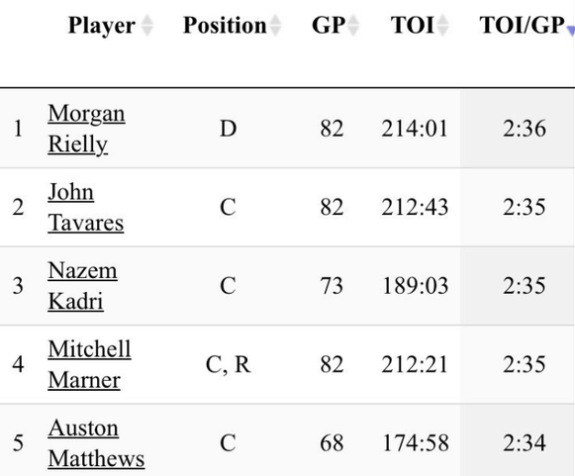
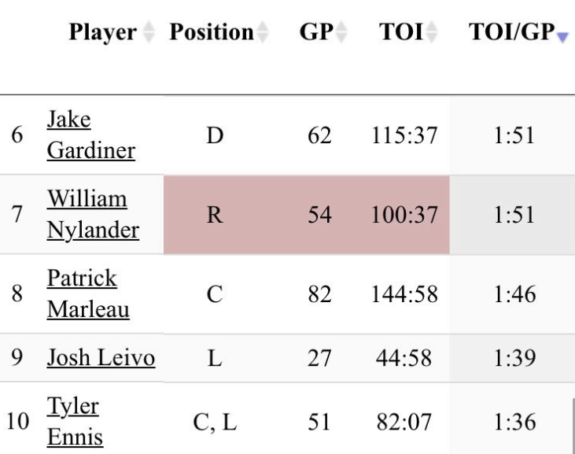
Evaluating the Florida Panthers’ Power Play
Unlike the Maple Leafs, the Panthers struggled early on with the man-advantage, going 15 percent in October. They recovered quickly, though, scoring 19 power play goals in November on 53 opportunities for a mark of 35.8 percent. They then cooled off slightly but still scored at an impressive 29.8 percent rate in December. Like the Maple Leafs, the Panthers hit a lull in January, but still scored on 21.4 percent of their power play opportunities. February saw another uptick at 26.5 percent, and they finished off March and April at 26.9 percent.

With an incredible 72 powerplay goals (second in the league) on 269 opportunities (third in the league), the Panthers finished with a conversation rate of 26.8 percent, good for second overall behind Tampa Bay.
But was their success solely a result of skill, or was there some puck luck at play?
The Panthers Relied on the One-Timer (And Some Luck)
McFarland’s power play set-up with the Panthers was far different from what we saw with the Maple Leafs. Rather than funneling pucks to the net, the Panthers relied heavily on one-timers from the right circle, usually from Mike Hoffman. This can be a viable strategy when you have elite shooting talent, and that might have been some of the logic behind this set-up.
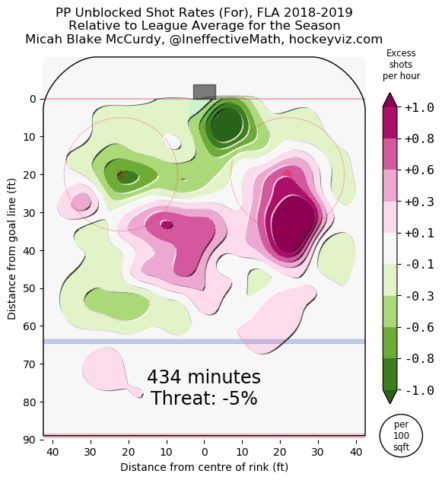
Going back to Meghan Hall’s work, the Panthers ranked sixth in expected goals at 7.9-per-hour and eighth in shots-per-second, with a 16.2 shooting percentage (fourth overall). Good power play numbers to be sure, but not elite like the Maple Leafs. The fact that the Panthers outscored Toronto makes you wonder if luck was on their side.
| Player | Powerplay Goals | Expected Goals (ixG) |
| Mike Hoffman | 17 | 8.26 |
| Aleksander Barkov | 13 | 6.76 |
| Jonathan Huberdeau | 11 | 7.11 |
| Evgenii Dadonov | 8 | 8.08 |
| Vincent Trochek | 3 | 3.13 |
Unlike the Maple Leafs forwards who generally scored fewer goals than expected, the top three Panthers forwards handily outscored their ixG. And while there are some talented players on that list, it would be hard to argue that Hoffman, Barkov, and Huberdeau have superior shooting ability to the Maple Leafs’ top players, yet the Panthers still managed to score more while generally shooting from further out. This is not to discredit the players or the power play unit as a whole, but it should raise some questions about the sustainability of their success.
Their power play results in 2017-18 seem to support this argument as well. The Panthers finished that season 21st in the league at 18.9 percent. Vincent Trochek was the only player who significantly outscored his ixG (13 goals with an ixG of 10), while their other top scorers were either at or under their expected production. This happened despite an arguably better power play set-up, where they generated more shots from closer to the net in traditional high-danger scoring areas.
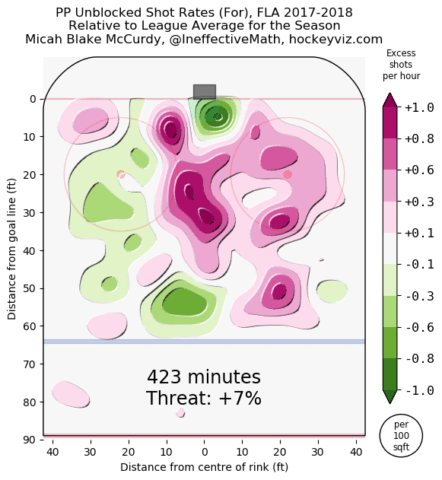
There are a few ways to interpret these results. The first and probably most logical interpretation is that the Panthers were unlucky in 2017-18, but also very lucky in 2018-19. Their true power play ability likely lies somewhere in between the results of both seasons. It’s just really hard to believe that their set-up was more effective than Toronto’s especially given the underlying numbers. The second interpretation is that McFarland was able to make significant adjustments in his second season with the Panthers, and capitalized on Hoffman’s shot. Historically, Hoffman has outperformed his ixG on the man-advantage, so there could be some merit to this argument too.
| Mike Hoffman Career PP Results | ||
| Season | Powerplay Goals | Expected Goals (ixG) |
| 2018-19 | 17 | 8.26 |
| 2017-18 | 8 | 6.23 |
| 2016-17 | 13 | 8.38 |
| 2015-16 | 9 | 4.23 |
McFarland Favours the First Line
It will come to the delight of Maple Leafs fans to hear that McFarland relied heavily on his first power play unit this season. Like Toronto, the Panthers loaded up their first unit with their best offensive players. And in some cases, they even used five forwards on the power play.

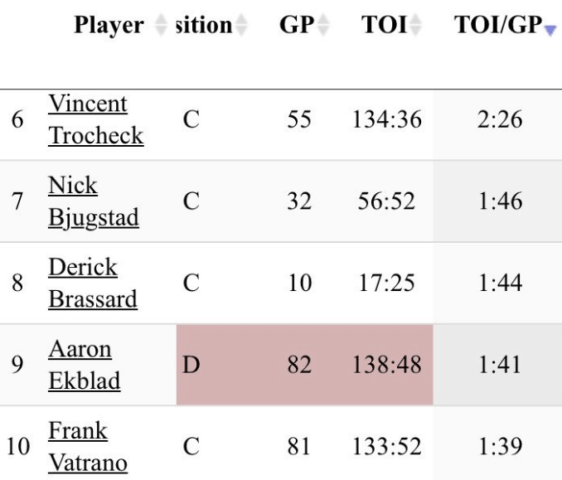
The first unit garnered about 3:30 of ice time per game, compared to 1:40 for the second unit. That’s a 66/34 percent split. Not a huge increase over the 60/40 split that was the norm in Toronto, but an improvement nonetheless. On a standard two-minute power play, this split would give the first unit 1:19, which is probably just around ideal.
What Should the Maple Leafs Expect From McFarland?
The Maple Leafs have a new power play coach coming in with huge expectations on his shoulders. One, because expectations are a constant in Toronto, and two, because he just coached the league’s second-best power play. But with all this information at hand, it’s hard to say if McFarland will be able to do much better than Hiller did.
Hiller coached the Maple Leafs power play to second in the league in 2017-18 and had an equally dangerous unit this season that was stifled by some bad puck luck, or lack of finishing depending on how you want to look at it. McFarland had an up-and-down two seasons in Florida, with the 19th ranked power play in 2017-18, but the second-best unit in 2018-19. The extent to which that unit’s success this season was dependent on luck is up for debate, but the analytics suggest that they overperformed.
Other than pure results, we can expect to see a few different things on the Maple Leafs power play next season. As mentioned above, McFarland likes to rely on the one-timer so perhaps he’ll implement that in Toronto. Matthews, for instance, usually sets up on his strong side to release his trademark wrist shot, but we’ve also seen how dangerous he can be on the off-wing. Look out for some experimentation in this regard next season.

Also mentioned was that he sometimes used five forwards on the power play, something that hasn’t caught on in the NHL yet, but will likely become more popular in the coming years. It points to McFarland’s forward-thinking approach to the game of hockey – certainly in alignment with philosophies held by general manager Kyle Dubas. It’s been suggested that McFarland may even act as a bridge between the Maple Leafs analytically-inclined front office and Babcock, so perhaps he can push the envelope more in that direction.
The Maple Leafs have a good one in McFarland by all accounts. He’s highly respected by those around the game and isn’t afraid to try new things. And that progressive approach behind the bench may be exactly what this team needs to take another step next season.
Team stats from hockey-reference.com and foxsports.com
Player stats from naturalstattrick.com